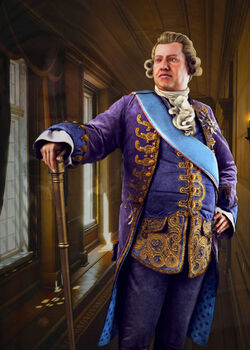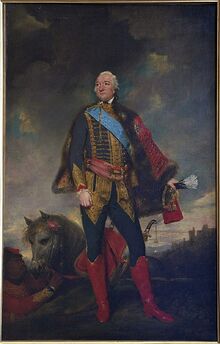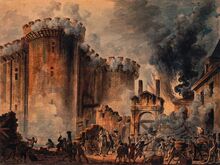- "A death penalty? A death penalty is a weak punishment – too weak, incidentally. My fellow citizens, in the name of liberty – in the name of the people – I do wish to come with a request: Why give the traitor of the people – my distant relative, Louis 16th of France – a death behind doors when we can publicly disgrace him? I vote death penalty, on the condition that Louis is being beheaded at the Place de la Révolution – in front of the people whom he have abominated for so many years."
- ―Louis Philippe to the National Convention at the eve of King Louis' execution, 1793
| Louis d'Orléans | |
|---|---|
 The Duke of Orléans | |
| Biographical information | |
| Born |
13 April 1747 |
| Died |
6 November 1793 (aged 46) |
| Political information | |
| Affiliations | |
| Real-world information | |
| Appears in | |
| Voice actor | |
Louis Philippe Joseph d'Orléans (aka Philippe Égalité) was born in wealth by the duke and duchess of Orléans, France. He was the Grand master of the French freemasonry, and a distant relative of the King. He was a part of the House of Bourbon, and lived in Paris during the French Revolution.
Louis was also a member of the radical extremist group of Templars that sworn their allegiance to François-Thomas Germain and his acolytes. Louis was a high-ranked Templar, and therefore he was trusted to lead the Order if Germain died before his plan was set out to life. Louis got granted with nine henchmen that were supposed to help him in his control of the citizens of Paris:
- Hélène Bastienne, countess de Torcy
- Anne-Josèphe Dumas, marquess de la Pailleterie
- Louis-Dominique François, marquis de Bullion
- Shamar al-Djin
- Édmound-Louis Bourienne
- Marguerite LaVenduz
- Alphonse Saint-Just
- Napoléon Bonaparte
- Renardo Solitario de Torres
- Lady Ethel Flintshire
At his death, Louis was killed by the Assassin-siblings Marie Anne and Pierre d’Le Louroux, and the Master-Assassin Laurent Mouzay.

How Louis Philippe was found by Germain
Early life[]

Louis Philippe as young, painted by Louis Tocqué
"Dogs are funny animals: they protect, love, hates and – sometimes – being bored with their masters; we have them only for hunting. Is that fair?"
– Louis Philippe to his mother while he is being painted by Louis Tocqué, 1752
Through his father, Louis Philippe was a member of the House of Orléans, a cadet branch of the French royal family. His mother came from a more distant cadet branch, the House of Bourbon-Conti. He was born at the Château de Saint Cloud, one of the residences of the Duke of Orléans a few miles west of Paris. His eldest sister, born in 1745, had died when six months old. His parents had another daughter, Louise Marie Thérèse Bathilde d'Orléans.
After his grandfather's death in 1752, Philippe d'Orléans inherited the title of Duke of Chartres. In 1769 he married Louise Marie Adélaïde de Bourbon, daughter of his cousin, the Duke of Penthiêvre, an Admiral of France and the richest man in the country. Since it was certain that his wife would become the richest woman in France upon the death of her father, Louis Philippe was able to play a political role in court equal to that of his great-grandfather Philippe II, Duke of Orléans, who had been the Regent of France during the minority of King Louis XV.
As Duke of Chartres, he opposed the plans of René de Maupeou in 1771 when Maupeou successfully upheld royal interests in a confrontation with the Parlement de Paris, and was promptly exiled to his country estate of Villers-Cotterêts in Picardy (now in Aisne) in northern France. When Louis XVI became king in 1774, Philippe was still suspected of anti-royalist sentiment in the eyes of the court. Marie Antoinette hated him for what she viewed as treachery, hypocrisy and selfishness, and he, in turn, scorned her for her frivolous and spendthrift lifestyle.
Becoming a Templar[]

Louis Philippe as the duke of Chartres, painted by Sir Joshua Reynolds
Templar: "Do you swear to uphold the principles of our order and all that for which we stand?"
The Duke: "I do."
Templar: "And never to share the secrets nor divulge the true nature of our work?"
The Duke: "I do."
Templar: "And to do so from now until death – whatever the cost?"
The Duke: "I do."
Templar: "You are now a Templar, harbinger of a New World. May the Father of Understanding guide us."
– Louis Philippe becoming a member of the Templar Order, 1770
François de la Serre[]
No one of Louis Philippe's family was a part of the Templar Order, but they were friend with someone who were: François de la Serre. De la Serre was a close friend of them, and also the Grand Master. De la Serre was 14 years elder than Louis Philippe, but he began to see a potential in the young man – who was a conservative aristocrat. The duke did not like de la Serre – politically, socially he was wonderful company.
De la Serre had a wife, Julie (a lieutenant within the Order), and she felt that Louis Philippe should not become a member of the Order – there was something that was not right. She felt that in the presence of him, Julie was being watched by a hawk. Louis Philippe did not even like her daughter, and Julie did not understood what monsieur de la Serre saw in him. Anyhow, Louis Philippe was recruited into the Order in 1770 – under the pseudonym of "The Duke".
Templar-business[]

Templar ignisa
As a member of the Templar Order, and under the pseudonym as "The Duke", Louis Philippe travelled around in France to advance the Order's interests. He come in touch with a silversmith – whom he never learned his name – and from him, he got a more radicalized view on the Templar Order: As the mankind's great architects, the Order had to guide the people; that could not be done with people like François and Julie leading the Order. Soon the silversmith was called back to France, by the Grand Master: François de la Serre – to make weapons for an army that countess de Torcy needed.
But since the Templar also served the King and his country, he had to travel to America and fight for France. They were on the loosing side in a war between the settlers, and needed help. Louis was sent to America to fight for the Frenchmen, and with him travelled the silversmith and a lot of Templars – who was supposed to help the New World Templars, also.
Back in France, Louis Philippe had a friend: Marquis de Bullion. The marquis could tell that while Louis Philippe had been in the New World, an extremist who carried the name Germain, and worked as a silversmith. Germain managed to collect not only a few, but a flock of Templars. They thought the same thought that Germain had told Louis Philippe: As the mankind's great architects, the Order had to guide the people.
Julie de la Serre[]
One day, Louis Philippe got a letter signed "G", where it said following:
"Dear brother d'Orléans
Monsieur de la Serre have possibly never mentioned me for you, but I do certainly know you. I have to tell you that in a recently meeting in Paris, lieutenant de la Serre (the Grand Master's wife, Julie) plans to give you a contract that you undoubtedly will fail. The result will be your death. To save yourself from the lieutenant's game, I have hired stalkers get rid of her. They only await your command.
– G"
Louis Philippe answered that he would personally be one of the stalkers to make sure that the lieutenant is being killed. He and two other stalkers found Julie and her daughter, Élise, in an alley in Versailles. He and the stalkers make themselves ready, but moments before they was supposed to strike, Louis Philippe withdraw: no children was supposed to be killed. The stalkers called him a wretch of a coward. The aristocrat still did not want to harm the little girl, so the stalkers went on – without Louis Philippe. The murder of Julie did not happened that night, but it came.
Julie died of a disease – which came at a strange point. The death of the Grand Master's wife shocked the French Templar Order. The pompously ceremony was held in Paris, and the body was buried at the Cimetière des Saints-Innocents. Even if Louis did not like Julie, he wanted to know if she died naturally or was killed by the same stalkers that was hired by "G".
Soon Louis Philippe found out that the people who had caused the death of Julie, was a Templar called Magdelaine Lévesque. She had arrived at the de la Serre estate in Versailles days before Julie died. Louis Philippe leaved to the estate and asked the majordomo, Olivier, what Magdelaine's motives for the trip was. The majordomo told that the french noblewoman arrived to discuss some transactions with Julie over a glass of wine. Wine! Louis Philippe was convinced that poison killed the Grand Master's lieutenant, Julie de la Serre.
Louis Philippe located the home of Magdelaine Lévesque's estate near Calais. To revenge the Grand Master's wife, the Templar Louis Philippe travelled to Calais – where he murdered Magdelaine with the same poison that she had used at Julie.
Eve of the revolution[]

Storming of Le Bastille
At the eve of the French revolution, Louis sat in a café at the Palais-Royale with his Templar-friends. They were proud of their project. Germain had told them which way this revolution would take, and the Templars smiled. The King would be removed, and the Templars would set in a new leader for France: Maximillien de Robespierre.
Louis Philippe's role was to slowly turn the politics in France against the King and the "let-them-eat-cake"-Queen, Marie Antoinette. The political arena belonged to Louis, Le Peletier and Robespierre.
Death[]
"The Templars are the true architects of this world."
– Louis Philippe at the deathbed, 1793
Assassination[]
After the execution of his relative, the King, Louis Philippe held a party at the Palais-Royale in the northern Paris. Here he suddenly saw a lady with a hood. The rest of the evening, he let his guards taste everything: food, wine – and even the knife, spoon, and fork set. This was a routine that would be repeated for the rest of his lifetime.
5th of November, Louis Philippe let his guard down – this resulted in his death. The Assassin-siblings Marie Anne and Pierre Étienne d'Le Louroux and the Master-Assassin Laurent Mouzay made their way into his estate in Paris, took out the guards, and killed him with a hidden blade. He was awake when he saw them and screamed – but no one came to rescue him, everyone of the guards was dead (the servants did not cared for him).
Last words[]
The Duke: "How can it end like this?"
Mare Anne: "You began to be slippy: you let your guard down."
The Duke: "That may be, but do you think my death will prevent the Templars' success? You Assassins can kill so many of us you will; we will never stop! The Templars cannot be stopped!"
Pierre: "You flatter yourself."
The Duke: "The Templars are the true architects of this world; what have you Assassins done for hundred of years? Nothing but kill the men in charge – men who created this world. Without us, the world would have stayed in the middle ages."
The Duke succumbed to his wound.
Laurent: "We may kill men in charge, but death of one suppressing Templar can free ten thousand citizens. Die now, knowing you – a Templar – even can free people, not just suppressing them. Repose en paix."
Marie Anne and Pierre: "Repose en paix."
The guillotine[]
François-Thomas Germain came to the estate the following day, and come over his corpse. Germain knew that soldiers were on their way to arrest and execute the duke. He therefore paid one of the servants to act like the duke for a day; the servant was suspicious, but could not refuse the value of 500 livres. Germain disappeared form the estate, and just moments after soldiers came and arrested the servant (who were in disguise as Louis Philippe)
The servant – playing the role as the duke – were brought to the guillotine and beheaded with the rest of the House of Bourbon.
Burial[]
Louis Philippe was buried in the Madeleine Cemetery, in Paris, where Louis 16th, Marie Antoinette and hundreds executed on the Place de la Révolution during the Terror had been buried. His remains were never found.
Skills[]
Louis was capable to control a sword and a pistol. He was always protected by brutes, and if somebody came on a distance of 5 meters, he would make his bodyguards escort the people away from the place. The only way that assassins could kill him, would be from above or with a ranged-weapon: rifle, pistol or Phantom blade.
Trivia[]
- Louis Philippe was a real historic character
- The poison Louis Philippe used to kill Magdelaine, is the same Pierre Bellec used to kill Mirabeau in Assassin's Creed: Unity
